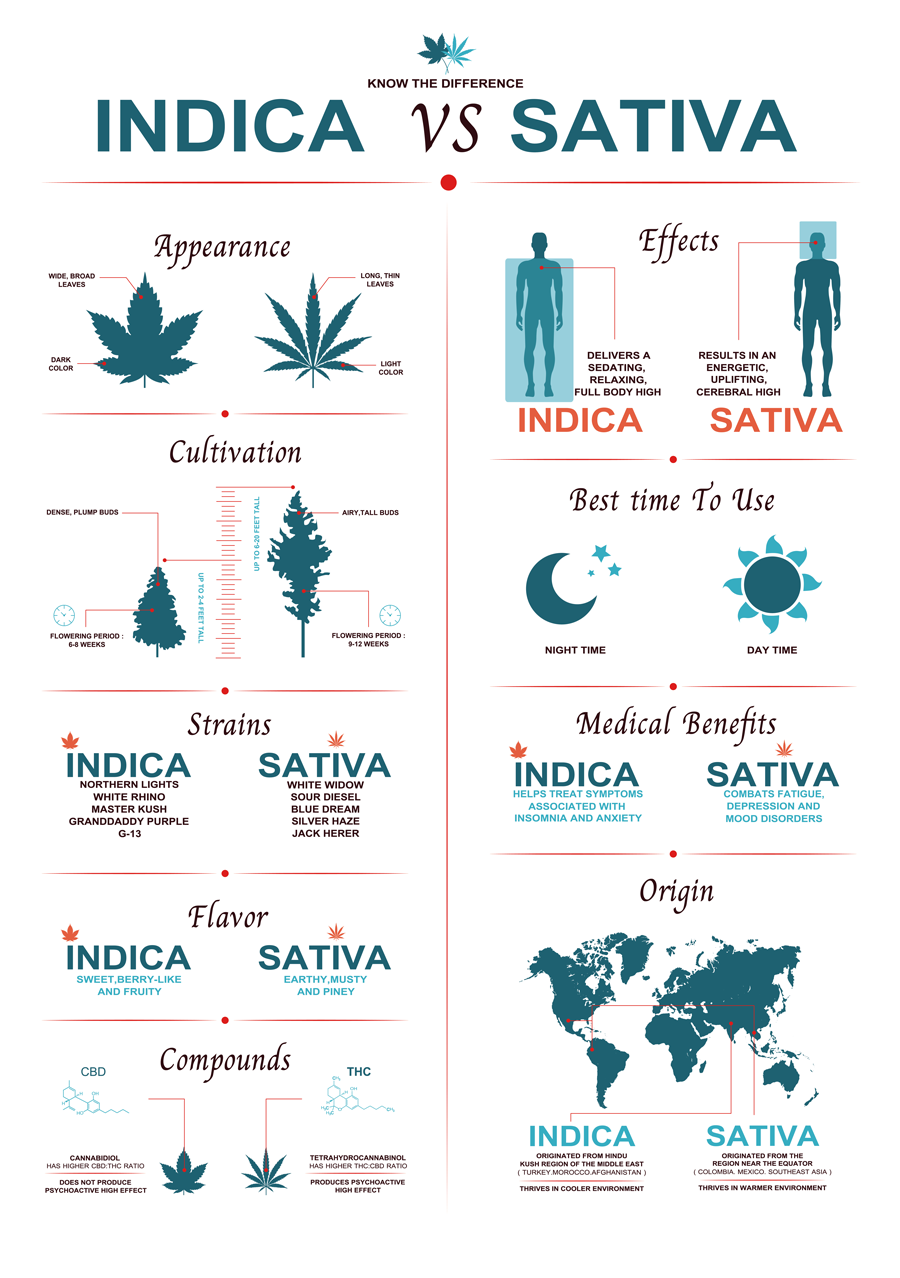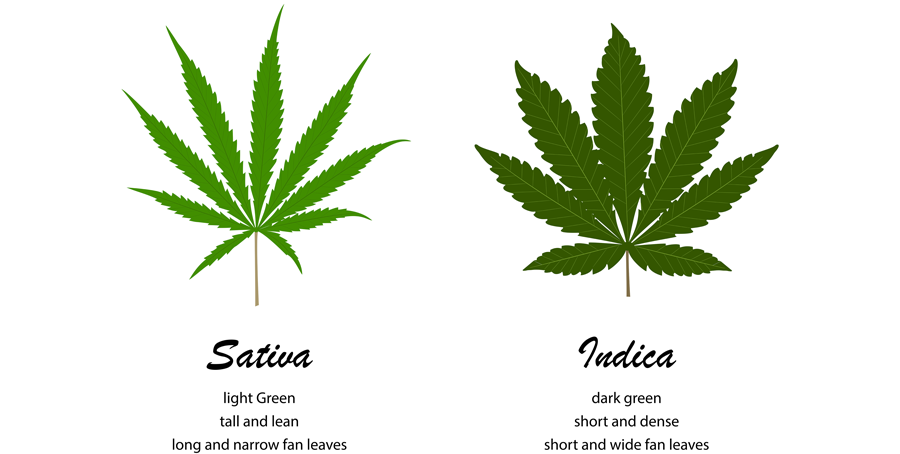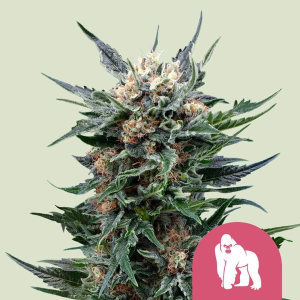Indica vs. Sativa play a versatile role in both medical and recreational use. It is particularly important to understand the differences between the two main types: Indica and Sativa, these differ not only in their appearance and growing conditions but also in their effects and chemical composition.
The Different Effects of Sativa vs. Indica
- Indica are known for their physically relaxing effects. They thrive in colder climates and are characterized by a higher CBD and lower THC content. Indica is often used to alleviate pain, anxiety, and sleep problems.
- Sativa, which thrive in warmer climates, have a higher THC and lower CBD content. Sativa promotes a feeling of euphoria and increased energy and is often used to enhance focus and creativity.
It is important to understand that cannabis affects everyone differently. Therefore, responsible use of Cannabis Sativa is essential.
Over the past decades, more than 1,000 cannabis strains have been developed. It is crucial for patients to be informed about the different effects of these strains to make an appropriate choice for their specific medical needs. Not every strain is equally suitable for every condition.

Medical Comparison
The essential difference between Indica vs. Sativa lies in their medical effects and impact on energy and productivity. Indica strains tend to be relaxing and are therefore preferred in the evening or at night. They can lead to intense relaxation in some patients, known as "couch lock."
In contrast, Sativa strains have an invigorating and mentally stimulating effect that can enhance creativity and productivity. While Indicas often provide "physical" relaxation, Sativas tend to offer a "mental high". However, Sativa plants require longer growth times and produce fewer flowers than Indica strains, making them less common on the black market.
Purchasing cannabis products on the black market carries the risk that patients may not receive the exact strain and quality they need. It is essential that medical cannabis is of known origin and properly grown, processed, and tested.
Modern cannabis breeders specifically develop a wide range of strains within the Indica and Sativa categories to meet the needs of specific patients. They take into account individual medical conditions, preferences, and lifestyles. Some patients need the calming properties of Indica, while others seek strong, non-opioid pain relief.
Since the effectiveness of cannabis varies from patient to patient, breeders offer a variety of strains to target specific conditions such as HIV/AIDS, cancer, fibromyalgia, glaucoma, Parkinson's disease, various types of arthritis, and epilepsy.
Sativa strains are often better suited for treating mental disorders such as depression, PTSD, and anxiety. Indicas, on the other hand, are often more effective against pain and inflammation and are therefore beneficial for patients with arthritis, fibromyalgia, and cancer. Many illnesses are accompanied by side effects such as depression and insomnia, highlighting the need for comprehensive treatment.
Regarding aroma, Indica strains tend to have earthy, skunky smells, while Sativas often smell sweet, fruity, or spicy. These differences are due to the terpenes present in the plant, which are closely related to cannabinoids like THC and CBD. These terpenes significantly contribute to the plant's medical efficacy.
Understanding Hybrids
Hybrids are unique cannabis strains created by crossing strains of different types. A hybrid combines many of the beneficial medical properties of its parent strains. Breeders can cross any two strains to develop a variety that provides optimal medical effects for specific diseases like lupus, multiple sclerosis, Crohn's disease, and epilepsy.
It is possible to mix any two strains to create a hybrid. Indica/Sativa hybrids are widespread and often known for their "alert mildness" and productivity. However, breeders can also cross Indicas with other Indicas or Sativas with Sativas.
Many hybrids offer a balanced compromise to relieve pain and inflammation without overly sedating the patient. Patients who need to medicate during the day often prefer Sativa-dominant hybrids, while those looking for maximum pain relief in the evening often switch to Indica-dominant strains.
Hybrids with a higher proportion of Indica or Sativa characteristics are referred to as "Indica-dominant" or "Sativa-dominant." Some strains are also characterized by a specific Sativa/Indica ratio, such as 60/40 Sativa/Indica.
Landrace Strains and Heirlooms
Landrace strains are those that have developed naturally in their own environment. They offer pure examples of Sativa or Indica, free from human intervention. Landrace strains are often 100 percent Indica or Sativa, shaped by thousands of years of adaptation to their environment.
Heirlooms are landraces grown outside their natural environment. These strains, valued for their pure Indica or Sativa characteristics, may lose some of their unique features when grown in a different climate.
Examples of landrace strains include Malawi Gold, a Sativa from Southeast Africa, and Panama Red, a Sativa from Panama. Landrace Sativas are found in regions with long summers and intense sun, such as Asia, Anatolia, and North Africa, while Indicas are typically found in Afghanistan, India, and Pakistan.
Regions such as Eastern Europe, the Himalayan region, and Siberia are home to Ruderalis strains, which play a role in traditional hash production.
What Determines Sativa or Indica?

Many readers already know that the characteristic aromas of many cannabis strains come from terpenes, special molecules that are similar to cannabinoids like THC and CBD.
A common misconception is that the content of a specific cannabinoid determines whether a cannabis strain is classified as Indica, Sativa, or Hybrid. In reality, it is often a terpene that influences this classification.
Myrcene, the most common terpene in cannabis, is known for its sedative and anxiety-relieving effects. Strains with a myrcene content of more than 0.5 percent are typically classified as Indica, while those with less than 0.5 percent myrcene are classified as Sativa.
This interaction is a good example of the entourage effect, a theory that cannabinoids and terpenes work together to enhance their medical efficacy. Many terpenes modulate the effects of key cannabinoids like THC.
New Strains and Their Development
New cannabis strains are continuously being developed, many of which are hybrids with special pain-relieving or anti-inflammatory properties. Some strains are particularly well-suited to treating nausea associated with chemotherapy, as experienced by cancer and Crohn's disease patients.
Given the varying medical efficacy of Indicas and Sativas, patients who legally use medical cannabis are advised to work closely with their doctor. The goal is to try different strains that have already helped other patients with similar conditions.
Patients should always look for the strains that best match their specific diseases, symptoms, and the side effects of their treatments. This can be a long-term project that requires months, sometimes even years, of effort. Patients are encouraged to continuously experiment with new strains to seek more effective options or a superior cannabinoid profile that promises better relief.
Since the effectiveness of Cannabis Sativa can vary greatly from person to person, advice from other patients should only be taken as a guide. The final evaluation of a specific Indica or Sativa strain is determined by individual use, especially in moments of acute discomfort such as pain, nausea, or insomnia.

Our interactive tool helps you find the ideal Cannabis Sativa strain based on your personal preferences and needs. Simply answer the following questions to receive a customized recommendation. Sativa vs Indica Recommendation
The choice between Indica and Sativa is crucial for the individual cannabis experience, whether for medical or recreational purposes. While Indica strains are appreciated for their relaxing and pain-relieving properties, Sativa strains offer invigorating and mentally stimulating effects. Hybrids combine the benefits of both types, providing tailored solutions for specific needs. It is important for patients and consumers to be informed about the various strains and to use cannabis responsibly to achieve the best results. Given the continuous development of new strains, understanding the unique properties of Indica and Sativa remains essential.
Disclaimer
This website's content is for informational use only and should not be considered medical or legal advice. Always consult a healthcare professional for health-related issues. Be aware of local regulations regarding cannabis cultivation. We are not liable for any actions taken based on this information.













